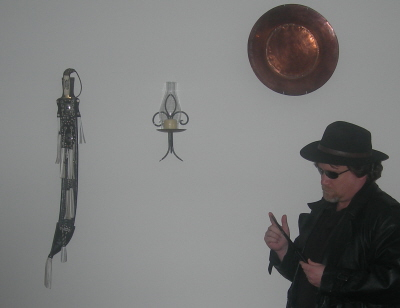|
About This Author
Come closer.
|
Complex Numbers
Complex Numbers
A complex number is expressed in the standard form a + bi, where a and b are real numbers and i is defined by i^2 = -1 (that is, i is the square root of -1). For example, 3 + 2i is a complex number.
The bi term is often referred to as an imaginary number (though this may be misleading, as it is no more "imaginary" than the symbolic abstractions we know as the "real" numbers). Thus, every complex number has a real part, a, and an imaginary part, bi.
Complex numbers are often represented on a graph known as the "complex plane," where the horizontal axis represents the infinity of real numbers, and the vertical axis represents the infinity of imaginary numbers. Thus, each complex number has a unique representation on the complex plane: some closer to real; others, more imaginary. If a = b, the number is equal parts real and imaginary.
Very simple transformations applied to numbers in the complex plane can lead to fractal structures of enormous intricacy and astonishing beauty.
August 15, 2023 at 11:31am August 15, 2023 at 11:31am
| |
Some science explaining from The Guardian (hence the British spelling):
I'll be using US spelling for my bits.
In February 2015, a Scottish woman uploaded a photograph of a dress to the internet. Within 48 hours the blurry snapshot had gone viral, provoking spirited debate around the world. The disagreement centred on the dress’s colour: some people were convinced it was blue and black while others were adamant it was white and gold.
Has it been eight and a half years already? I guess so. As with so many things on the internet, the followup took a dark turn  later. later.
Everyone, it seemed, was incredulous. People couldn’t understand how, faced with exactly the same photograph of exactly the same dress, they could reach such different and firmly held conclusions about its appearance.
It shouldn't be that surprising. We're still arguing over how to pronounce .gif (it's a hard g, by the way), and that format is like 30 years old at this point.
The confusion was grounded in a fundamental misunderstanding about colour – one that, despite mounting evidence to the contrary, shows little sign of disappearing.
That's at least partly because anchoring bias, where you stick with the first thing you learn about something, is rampant.
For a long time, people believed that colours were objective, physical properties of objects or of the light that bounced off them. Even today, science teachers regale their students with stories about Isaac Newton and his prism experiment, telling them how different wavelengths of light produce the rainbow of hues around us.
That's not really a bad thing, or even basically wrong. It may be simplistic, but that's nothing surprising when it comes to explaining science concepts to grade-school students. What's arbitrary is that Newton, who bridged the worlds of mysticism and science, assigned seven color names to what's really a continuum—seven being a magical number associated with astrology and the days of the week, among other things.
But this theory isn’t really true. Different wavelengths of light do exist independently of us but they only become colours inside our bodies. Colour is ultimately a neurological process whereby photons are detected by light-sensitive cells in our eyes, transformed into electrical signals and sent to our brain, where, in a series of complex calculations, our visual cortex converts them into “colour”.
The point of using a prism, or observing a rainbow in the sky, is that the refraction angle of light through a medium (glass or mist) depends on wavelength, which is how you get rainbows and Pink Floyd album covers.
One cause of the problem – or perhaps its symptom – is language. In English we divide colour space into 11 basic terms – black, white, red, yellow, green, blue, purple, brown, grey, orange and pink – but other languages do things differently.
Know how I know the author is male? Because he left out fuchsia, chartreuse, turquoise, etc. Also, his name is James. But mostly it's the color names.
You'll note I said seven above while this list is longer. Newton reported red, orange, yellow, green, blue, indigo, and violet. Black and white aren't spectrum colors. Brown is basically dark orange. Pink is light red. Purple is weird and I don't have time to get into why right now (or why it's not really the same thing as violet). Indigo was totally made up by Newton so he'd have seven colors.
Many don’t have words for pink, brown and yellow, and some use one word for both green and blue. The Tiv people in west Africa use only three basic colour terms (black, white, red), and at least one Indigenous community has no specific words for any colours, only “light” and “dark”.
This could easily send me off on one of my "language shapes and reveals how we perceive the world" rants, but, to borrow a term from optics, I'm focusing on different stuff here.
The Aztecs, who were enthusiastic farmers, used more than a dozen words for green; the Mursi cattleherders of Ethiopia have 11 colour terms for cows, and none for anything else.
We have special color names for horses.
The meanings of colour are no less socially constructed, which is why a single colour can mean completely different things in different places and at different times. In the west white is the colour of light, life and purity, but in parts of Asia it is the colour of death. In America red is conservative and blue progressive, while in Europe it’s the other way around.
This last bit has long amused me, because red represents both the Republican party in the US and the Communist party in China (and in the former USSR).
There's a bit more at the link; I'm afraid I copied way more than I usually do, here. It ends, in proper British fashion, on a pun, which I always appreciate. The point, though, is something I've been saying for some time: that color isn't an intrinsic property of things. Wavelength, however, is measurable and objective (it is, in part, how we know the chemical composition of distant stars).
That dress, incidentally? It's always blue and gold to me. No amount of staring or mental gymnastics can change my perception of it. Other optical illusions, usually, become clear to me upon reflection (pun intended). This one's persistent. And after almost 10 years, it still reminds me that we all have different perceptions. And I do need reminding of that, from time to time. |
© Copyright 2025 Robert Waltz (UN: cathartes02 at Writing.Com). All rights reserved.
Robert Waltz has granted InkSpot.Com, its affiliates and its syndicates non-exclusive rights to display this work.
|

